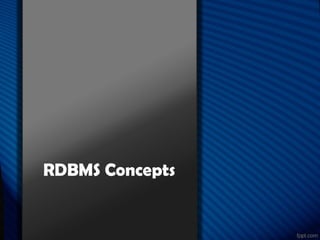
Sql server ___________session_1-intro
- 2. Data and Database • Data means information and it is the most important component in any work that is done. • A database is a collection of data. • Thus, a database is a collection of data that is organized such that its contents can be easily accessed, managed, and updated. Database Users Allows to Access Information Stores Information
- 3. Data Management • Data management deals with managing large amount of information, which involves both the storage of information and the provision of mechanisms for the manipulation of information. • The two different approaches of managing data are: – File-based systems – Database systems
- 4. Problems with file storage The process of manually maintaining data through files is : – Tedious – Time consuming – Error prone.
- 5. File-based systems • Disadvantages of File-based Systems are: – Data Redundancy and Inconsistency – Unanticipated Queries – Data Isolation – Concurrent Access Anomalies – Security Problems – Integrity Problems
- 6. Database Systems • Solved issues of handling large volume of data. • Used to store data in an efficient and organize manner. • Allows quick and easy management of data. • Data is more permanent and long-lasting.
- 7. Advantages of database systems: • The amount of redundancy in the stored data can be reduced. • No more inconsistent data. • The stored data can be shared. • Standard can be set and followed. • Data integrity can be maintained. • Security of data can be implemented. Database Systems
- 8. Database Management System (DBMS) • It is a collection of related records and a set of programs that access and manipulate these records. • DBMS provides an environment that is both convenient and efficient to use when there is a large volume of data and many transactions to be processed. • It enables the users to define, create, and maintain the database and provides controlled access to this database.
- 10. Benefits of DBMS • The benefits of typical DBMS are as follows: – Data Storage – Data Definition – Data Manipulation – Data Security and Integrity – Data Recovery and Concurrency – Performance – Multi-user Access Control – Database Access Languages
- 11. Database Models • Databases can be differentiated based on functions and model of the data. • A data model describes a container for storing data, and the process of storing and retrieving data from that container.
- 12. Database Models
- 13. The Hierarchical Model DEPARTMENT D_NAME D_NUMBER MGRNAME MGRSTARTDATE NAME SSN BDATE ADDRESS a. DEPARTMENT: Research Administration EMPLOYEE: Smith Max John Grace Elite James Frank b. DEPARTMENT: Research Administration PROJECT Product A Product B Computerization New benefits PROJECT PNAME PLOCATION EMPLOYEE PNUMBER
- 15. Relational Data Model • In the relational model, there is no physical link. All data is maintained in the form of tables consisting of rows and columns. • Data in two tables is related through common columns.
- 16. Relational Database Management System (RDBMS) • A Relational Database Management System (RDBMS) is a database management system where all data visible to the user is organized strictly as tables of data values, and where all database operations take place on these tables. • A relational database is a database divided into logical units called tables, where tables are related to one another within the database.
- 17. Terms related to RDBMS These terms are mostly used in RDBMS: Data is presented as a collection of relations. Each relation is depicted as a table. Columns are attributes. Rows (“tuples”) represent entities. Every table has a set of attributes that are taken together as a “key” (technically, a “superkey”), which uniquely identifies each entity.
- 18. Terms related to RDBMS Term Meaning Relation A table Tuple A row or a record in a relation Attribute A field or a column in a relation Cardinality of a relation The number of tuples in a relation Degree of a relation The number of attributes in a relation Domain of an attribute The set of all values that can be taken by the attribute Primary Key of a relation An attribute or a combination of attributes that uniquely defines each tuple in a relation Foreign Key An attribute or a combination of attributes in one relation R1, which indicates the relationship of R1 with another relation R2 The foreign key attributes in R1 must contain values matching with those of the values in R2
- 19. Entities and Tables • An entity is a person, place, thing, object, event, or even a concept, which can be distinctly identified. • Each entity has certain characteristics known as attributes. • A table contains a group of related entities called an entity set. • The terms entity set and table are often used interchangeably. A table is also called a relation, rows are known as tuples and columns are known as attributes.
- 20. Entities and Tables Emp_No Emp_Name Emp_DOB Emp_DOJ 345 James 24-Sep-1968 30-May-1990 873 Pamela 27-Jul-1970 19-Nov-1993 693 Allan 10-Sep-1970 01-Jul-1992 305 Geoff 12-Feb-1973 29-Oct-1996 AttributesTable Tuples
